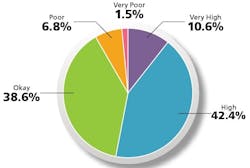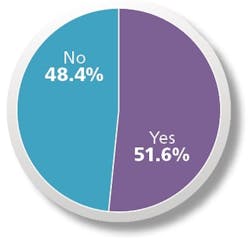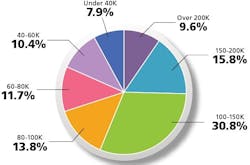A career in pharma is no soap opera, but it can often feel like one. Managing a career, especially one that often requires advanced degrees and intensive and sustained professional focus, is tough enough without the added drama of the ups and downs of the commercial marketplace. And so it goes for many working on the pharmaceutical industry stage who are toiling diligently to meet their employer’s business goals as well as their own career aspirations. Each year since the magazine began publishing in 2002, Pharmaceutical Manufacturing has surveyed its readership to gain a sense of how folks are doing career-wise, as well as to get an idea of how their attitude reflects current and future trends.
Response to this year’s study was relatively strong with 268 completing surveys and 240 readers offering a response to every one of the questions (because readers were not required to answer each question).
MARKET EFFECTS
Figure 1. Please rate your overall level of job satisfaction.
There should be little doubt that pharma is moving in some new and interesting directions. While there is no need to recite the industry’s current catechism of looming patent cliffs, diminished blockbuster opportunities and more direct regulatory oversight of manufacturing operations, pharma and life science companies are reacting to market forces in a variety of familiar ways. Chief among them is the way companies, by necessity, are arranging themselves to be competitive and successful. Asked “How have market and competitive forces affected your company recently?” 43.5 percent chose “Major business unit or operations restructuring.” The response, similar to last year, points to a dynamic that has the ability to either kill or launch one’s career in pharma. Mergers or acquisitions came in second place at 36.6 percent, which is not surprising; in 2015, some of the largest M&A deals were in the pharmaceutical sector. According to analysts at PwC, “transformational deals” (transactions valued at $10 billion and above) accounted for 58 percent of total deal value in the first half of the year. Huge pharmaceutical “megadeals” including AbbVie’s $21 billion deal for Pharmacyclis and Pfizer’s $17 billion deal for Hospira, garnered 17 percent of total M&A deal value - some $150 billion says Forbes Magazine - for the first five months of 2015.These upheavals can cause a lot of angst among employees. In a flip from last year, 52.5 percent (as opposed to 48 percent in 2015) indicated they were more concerned with job security than last year. What are they concerned with? Top of mind for most (55.5 percent) was the fear that internal cost-cutting (often the familiar outcome of mergers and/or acquisitions) may soon have a negative impact on their careers. Others (25.6 percent) identified “External financial pressure on my company due to expiring patents or circumstances surrounding failed product development or regulatory approval.” Again, business circumstances and other events that trigger organizational moves to manage costs, trim redundant functions, lop off idle capacity, etc., have always been identified as a job security pain point for PhM’s readers. Here’s one reader’s appraisal: “I was satisfied with the variety and the assignments - when it was held by a major company. My site was independently run but was still overall controlled by a larger company. Pay was adequate, even though the work was hard and there was a lot of it! Job security was assured. Opportunities for growth were great - afraid things will change drastically under new ownership!”
Figure 2. What were the biggest challenges you had to face in the past year?
Through their answers, we gather a pretty clear picture of the demographic profile of those responding. Not surprisingly, respondents are mostly male; gender was split in their favor 80 to 20 percent (of 240 total responding) and maturing, with some 42.7 percent 55 older, followed by those 40-54 holding down the fort. Yes, there are younger professionals out there, but at 2.9 percent for 20-29 year-olds and 13.8 percent for 30-39 year-olds, it’s clear that the industry is graying. PhM’s readers are by most measures pretty smart. Nearly 20 percent of those responding indicated they have a Doctorate, another 23 percent a Masters in something other than Business, and most remaining (38.6) possessing a Bachelor’s degree. We did catch a few responses from those in the trades and those (perhaps) working the line with high-school degrees. Of those with degrees, most have either a Chemical Engineering, Pharmaceutics or Chemistry degree, with the rest possessing Business, Electrical Engineering, Mechanical Engineering, Bio Chemistry and similar technical or science-oriented educational backgrounds.One of the great things about PhM’s 2016 Reader Survey is that we tap into the ethos of operational types. This year, most (70.9 percent) fill operational roles (sum of operational categories) with nearly a quarter (23.2 percent) specifying involvement in quality assessment and quality control, and 17.4 percent identifying themselves with manufacturing operations. Research and development types were represented as well, with 16.6 percent. In single digits are the rest, with PhM readers working in plant engineering and design, IT and facility management to round out the occupational orientation of those responding. Regardless, PhM is reaching the veterans, with 49 percent indicating they’ve been in the industry more than 20 years. The next largest group (30.7 percent) have 11-20 years experience, with the remainder ranging from one to ten years running their “lines” on the pharma stage.
Responding readers represent the diversity in pharma - parsed rather evenly across the industry’s major segments, responding readers come from all sectors including Contract Manufacturing, traditional “Big” Pharma, Generic Pharma, Bio Pharma and small or midsized specialty pharmaceutical manufacturers.
Figure 3. How would you rate the suitability of your skills to manage current responsibilities?
MORE MONEY, MORE HAPPINESS?
It’s been said a million times that money can’t buy happiness, but it can buy you things that make you happy. Most all responding measured their “satisfaction” as positive. Those rating it “High” were legion, with 42.4 percent indicating they were pretty happy with their jobs all things considered. Some, apparently, are ecstatic (“Very high” 10.6 percent). A big chunk, 38.6 percent, indicate that satisfaction was “Okay” which for most people is reality and (again) all things considered, a decent place to be attitude-wise; especially in pharma. Fortunately, those feeling not-so-great about things and rating satisfaction as “Low” or “Very low” were only about 9 percent of total respondents.
As mentioned, there is a bit of angst out there concerning job security. Market forces are adding to the burn and readers identified a number of events that trigger concern. More outsourcing, plant closings and similar events are making their mark, good and bad, on people’s careers. What are the keys to pharma employee satisfaction? In the middle of the pack were “Opportunities for Advancement,” “Salary and Benefits,” and “Job Security” garnering 17.4, 17.8 and 14 percent (respectively) of our respondent’s choices. What is really interesting is that most of PhM’s responders (32.6) indicate “Challenging Work” brings them the most satisfaction. Here’s how one of PhM’s readers articulated it: “My new position offers me a blank canvas on which to lay out and execute my vision for various new initiatives. It is challenging mostly because I have never done much of what I intend to do, but I am finding that my colleagues are a huge andhelpful resource. I also do not have constant micromanagement, which has allowed my creativity to flourish.”
Figure 4. Does your company offer access to a formalized program of training to support business or operational excellence goals?
So, what were some of those challenges? Again, restructuring and M&A activity set the stage. We asked readers what were their biggest challenges. Overwhelmingly, 58.1 percent cited “Increased workload due to organizational change,” winning the People’s Choice Award when it comes a career in pharma. Others were challenged by “New product introductions” (30.8 percent), “Plant or business expansion” (24.2 percent) and 21.9 percent indicating a “New role or position internally” got people’s hearts racing.STAYING RELEVANT
For any professional in pharma, the biggest challenge career-wise is staying relevant, with skills and experience that are valued by colleagues and employers, over the span of one’s career. New systems, new processes, new products … new … whatever, will always be a part of one’s pharma career. Keeping pace with industry change is a paramount priority. How do PhM’s readers feel? Most are confident that they are up to the challenge; “How would you rate the suitability of your skills to manage current responsibilities?” 60.4 percent indicated, “My skills and background are well suited to my current duties.” The responses to the question also indicated some of the resilience and flexibility one needs to stay relevant — “I am being asked to do some tasks outside my skill set, but am generally able to execute them without specific training,” 25.2 percent of respondents offered that resolute assessment.
Figure 5. What is your current annual gross salary?
Are companies supporting continued relevance and competence with training? According to responses, half said their companies offered formal training and the other half said they did not. For those employed by companies that do offer formalized training we asked for comments. They ranged from cynical to superlative, but one stood out: “The majority of staff that participate in these training programs have a lot of free time, and are not very experienced. When they complete the training, they are credited as experts, though they know only a few things; the training is not at all comprehensive, yet they are treated like they know more than others. It’s a Dilbert comic strip that isn’t funny...” Just another indicator that in a large, corporate environment good intentions and resources do not necessarily translate into effective workforce development tools.THE SHOW MUST GO ON
It’s clear from this year’s study that the actors on the pharma stage are, by-in-large, satisfied with their careers, relatively happy with their organizations and confident their skills and abilities will keep them relevant and valuable to their employers. Although money is a big part of overall career satisfaction, most of PhM’s responding readers find the industry’s challenges as a primary driver of career satisfaction. Bravo!











